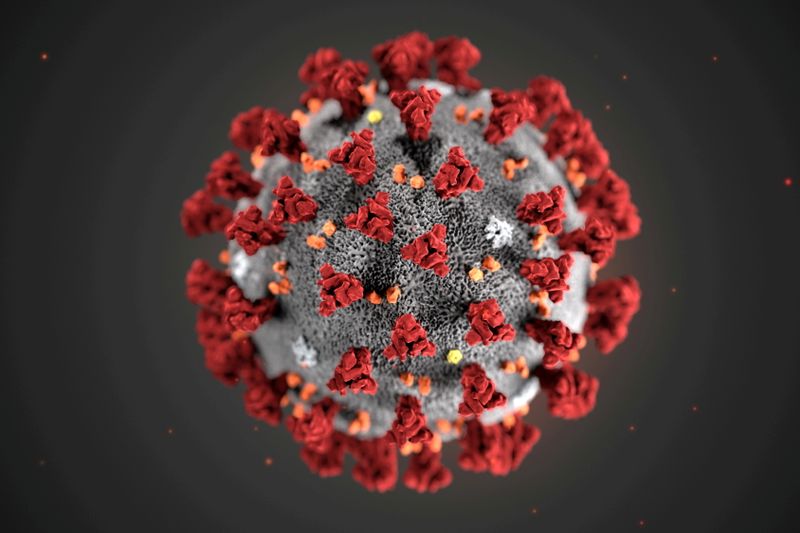(This June 7 story corrects affiliation of Zhiqiang An in first item)
(Reuters) – The following is a roundup of some of the latest scientific studies on the novel coronavirus and efforts to find treatments and vaccines for COVID-19, the illness caused by the virus.
New antibody drug appears promising in mouse studies
An experimental new type of antibody drug from IGM Bioscience Inc may be more potent at inhibiting the coronavirus and its variants than antibody therapies currently in use, research in mice suggests. And it is easier to administer with more direct affect on the lungs. Current antibody drugs use so-called IgG antibodies, which are bivalent (two-armed) – meaning they can simultaneously attach themselves to two of the spikes the coronavirus uses to break into cells. The IgM antibody is 10-valent (10-armed), so it can bind up to 10 viral spike proteins at the same time, explained Zhiqiang An of the University of Texas Health Science Center at Houston and Pei-Yong Shi of University of Texas Medical Branch at Galveston, who are among the authors of a report in Nature. The IgM antibody can therefore bind more strongly and effectively to the virus, they added. The IgM antibody showed broad coverage of variants of concern, the researchers said. Furthermore, it can be given via nasal spray, whereas conventional antibody drugs require intravenous infusions. The IV-infused IgG antibody must be given in high doses because most of it stays in the blood, with very limited anti-viral effects in the respiratory tract. Nasal delivery would allow for lower doses and direct access to the respiratory tract and lung. It also could be self administrated without medical supervision, researchers said. However, the drug must still be tested in humans to gauge its actual impact on COVID-19 treatment, An said. (https://go.nature.com/34ZYiGV)
E-cigarettes may increase lung vulnerability to coronavirus
Vaping has been linked with higher rates of COVID-19 in some studies. A small new study has found that lung cells exposed to fluid from e-cigarettes appear more vulnerable to the spike protein that the coronavirus uses to break into cells. In test tube experiments, researchers took samples of cells that line the lungs and exposed some of them to liquid used in Juul e-cigs. Then they exposed the cells to a harmless virus that had been coated with the spike protein from the coronavirus. The researchers saw higher rates of infections in the lung cells that had been treated with e-liquid, compared to unexposed cells, according to a report posted on Sunday on bioRxiv ahead of peer review. Nicotine may contribute to the higher infection rate in e-liquid-treated cells, the authors speculate, but they do not know for sure. “Our results strongly urge consideration of vaping as a risk factor for COVID-19,” they said. (https://bit.ly/2RwWjXx)
Bots are disseminating much COVID-19 misinformation
Automated computer programs, or “bots,” are spreading a lot of COVID-19 misinformation on social media, new research confirms. Bots are easy to spot, said Dr. John Ayers of the University of California, Davis. “You just look for coordinated behavior, like Facebook groups sharing the exact same content within seconds,” he said. The study analyzed 299,925 posts made to 563 Facebook groups, identifying groups that seemed especially susceptible to bot influence. In these groups, identical links were shared at average intervals of 4.28 seconds, compared to 4.35 hours for groups least influenced by bots, the researchers reported on Monday in JAMA Internal Medicine. Then they monitored posts sharing a link to a study in which masks were found to protect against COVID-19. Where bots had the most influence, the posts sharing the trial were 2.3 times more likely to report false results and 2.5 times more likely to make conspiratorial claims than those showing up on groups least influenced by bots. Instead of zeroing in on bots, social media companies continue to evaluate whether individual posts contain misinformation, Ayers said. “That’s like playing ‘Whac-A-Mole,'” he said, adding that bot-generated misinformation “could be undermining critical health institutions.” (https://bit.ly/3gicVui)
Open https://tmsnrt.rs/3c7R3Bl in an external browser for a Reuters graphic on vaccines in development.
(Reporting by Nancy Lapid and Linda Carroll; Editing by Bill Berkrot)























